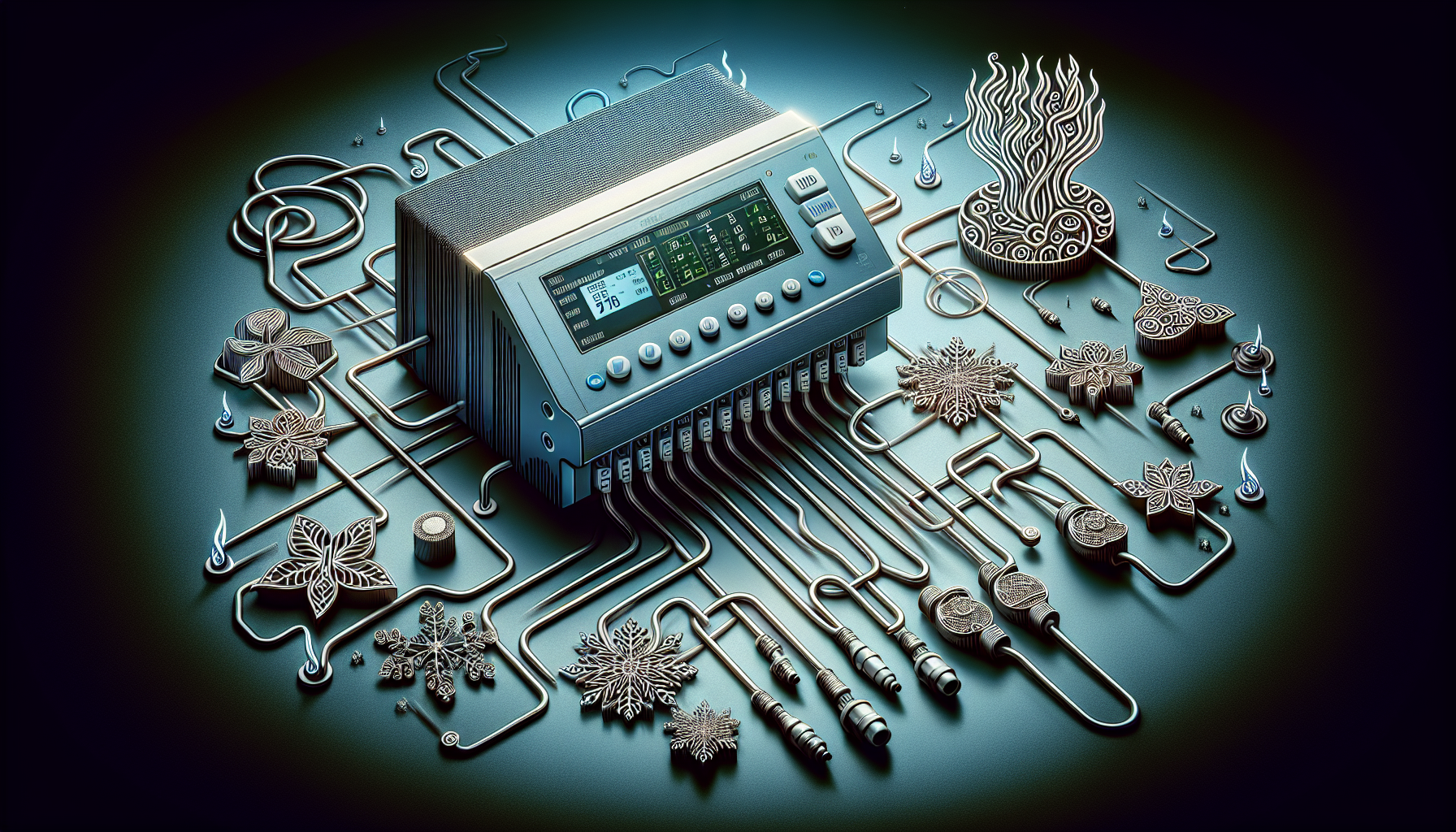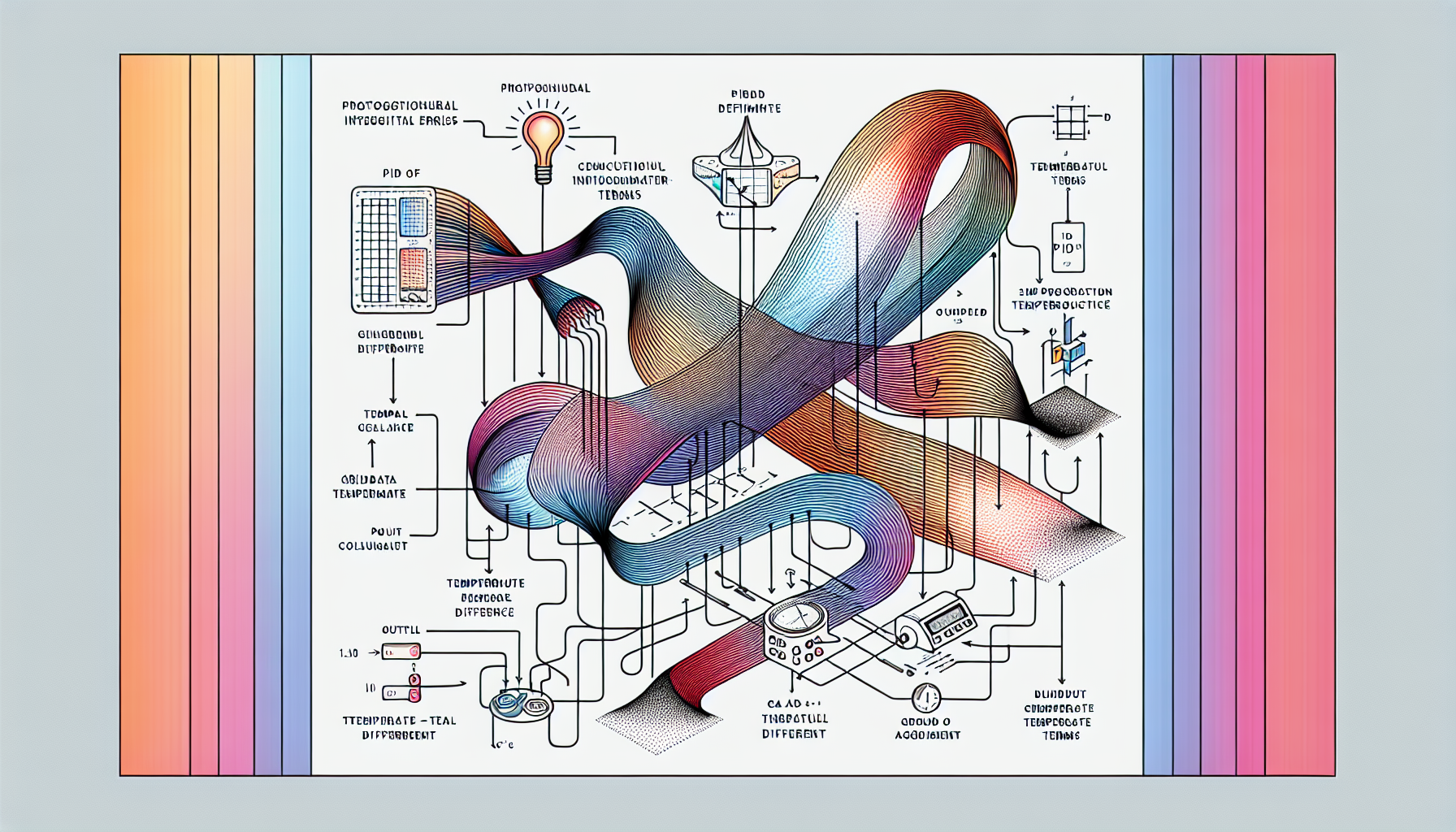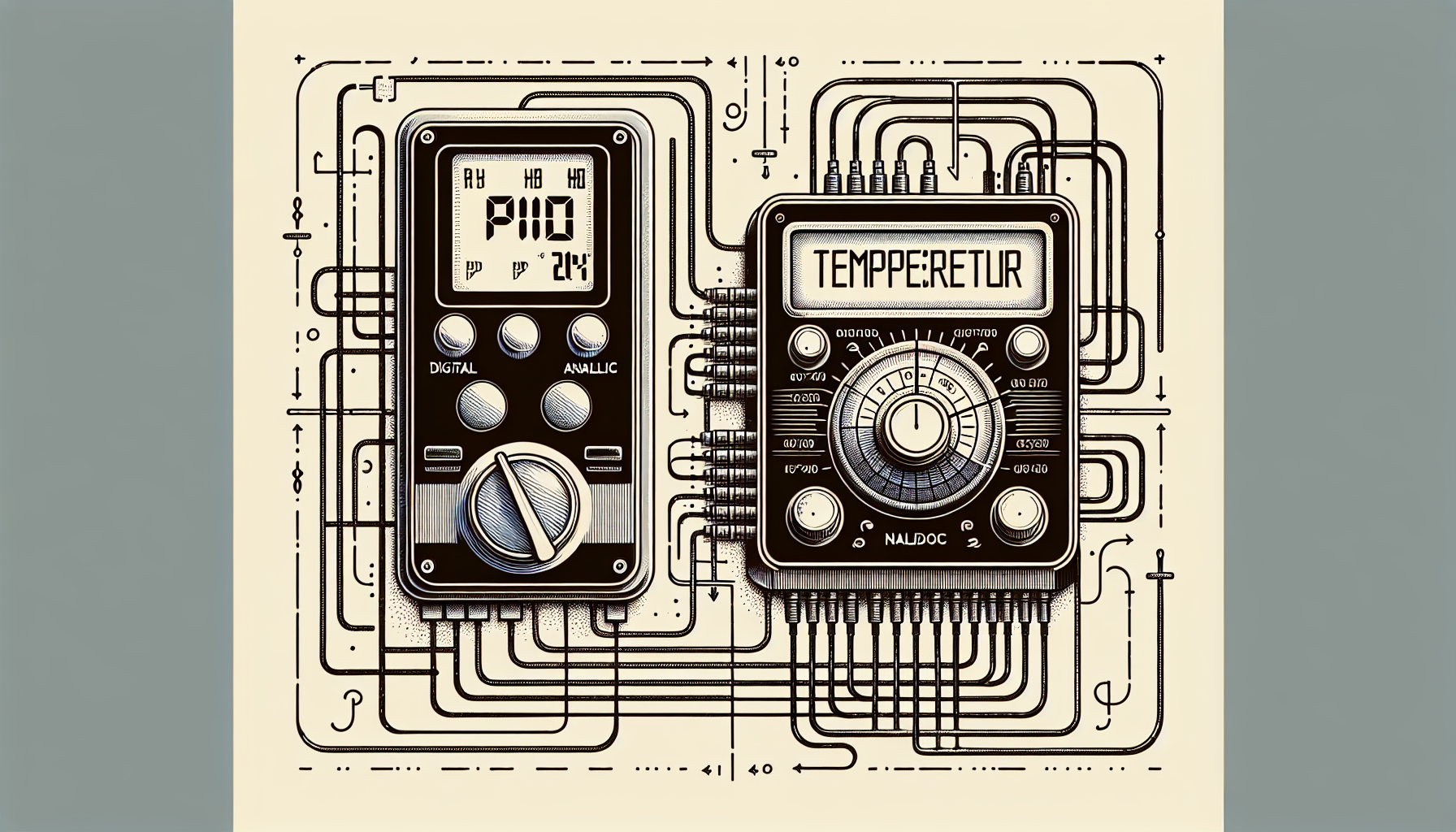The Benefits Of A PID Temperature Controller & How They Work
If you’ve ever wondered, “How does a PID temperature controller work?”, here’s the straightforward explanation: it uses a feedback loop informed by the Proportional, Integral, Derivative (PID) algorithm to regulate temperature accurately. The device constantly adjusts power outputs to match the desired temperature setpoint, providing tight control without constant manual intervention. This article demystifies the PID algorithm and shows its effectiveness in various industrial and commercial settings.
Key Takeaways
- PID temperature controllers use the Proportional Integral Derivative algorithm to maintain precise temperature control with minimal human intervention. They adjust the power to heating or cooling elements based on continuous feedback from temperature sensors.
- Effective PID control requires fine-tuning of proportional, integral, and derivative parameters to minimise temperature deviation, achieve steady state precision, and anticipate future temperature changes, enhancing overall system stability and responsiveness.
- When implementing PID temperature controllers, factors such as temperature range, accuracy, output signal compatibility, environmental conditions, and system integration must be considered to select the appropriate device for achieving optimal temperature control in industrial applications.
Unveiling the PID Temperature Controller

The PID temperature controller is a sophisticated temperature control device that is a marvel of engineering. It plays a pivotal role in numerous temperature-dependent processes. This ingenious device harnesses the power of the Proportional Integral Derivative (PID) algorithm, coupled with a continuous feedback loop, to maintain the desired temperature. It’s all about balance; the temperature controller PID deftly adjusts power to heating or cooling elements, much like a conductor leading an orchestra, ensuring each section plays in perfect harmony.
You might wonder how this conductor discerns the right moment for a crescendo or a diminuendo. Enter the temperature sensor, the vigilant watchman that constantly relays the actual temperature to the PID controller. The controller, in turn, compares these readings to the setpoint—the musical score to which the process must adhere. Through this dynamic, the PID temperature controller orchestrates precise temperature control with minimal need for human intervention, creating a symphony of efficiency and stability.
The PID Control Algorithm Explained

A closer examination of a PID temperature controller exposes a mathematical maestro at work—the PID control algorithm. This intricate formula is the brain of the operation, conducting the proportional, integral, and derivative terms in a calculated performance to minimise the error between the current and desired temperatures. It’s this error signal that the algorithm interprets, transforming it into a finely-tuned output that adjusts the temperature to the exact pitch of the process variable, all within a closed-loop system that epitomises precise control.
Proportional Action in Temperature Regulation
Proportional control action starts our temperature control symphony. Imagine you’re driving and slightly off course—the proportional term is like the gentle steering correction that brings you back towards your intended path. The difference between the desired temperature, our set point, and the actual temperature, our process variable calculates this term. The proportional gain determines the alacrity with which the system responds, ensuring that temperature deviations are met with a prompt yet measured reaction.
However, like an overzealous steering wheel can cause a vehicle to swerve, a high proportional gain might induce oscillations, causing the temperature to fluctuate around the desired level. This is where the art of tuning comes into play, striking the right balance to prevent instability. Yet, proportional action alone can’t always bring the system to an exact halt at the set point, akin to a car that slows down as it nears its destination but doesn’t stop completely without a little extra push.
Integral Action for Steady State Precision
Next, we have the integral action, the relentless force that compensates for past errors—think of it as a memory bank of temperature missteps. It’s the element that ensures not just a quick correction but a lasting one by accumulating the errors over time. This historical perspective allows the system to eliminate the residual difference between the actual and the desired temperature, ensuring the process variable rests precisely at the set point without any lingering offset or steady-state error—a tribute to the power of steady-state precision.
Yet, integral action requires a delicate touch. It can lead the system astray without careful tuning, akin to the Ziegler-Nichols method, causing it to overshoot the mark and become unstable. Patience and precision are paramount, ensuring the integral term contributes to a harmonious control system that faithfully maintains the desired temperature as its steady state.
Derivative Terms for Anticipatory Control
Finally, we meet the derivative term, the future-oriented part of the PID algorithm that anticipates the direction of the temperature. It’s the lookout on the ship’s crow’s nest, keeping an eye on the approaching storm or, in our case, the rate of temperature change. By factoring in the speed at which the temperature approaches the set point, the derivative term acts as a dampener, smoothing out any potential overshoot and ensuring the system remains stable and reactive.
This predictive aspect of the derivative term is akin to applying the brakes before reaching a sharp bend in the road, reducing the likelihood of going off course. It’s a testament to the intricacies of the PID control system and its ability to provide anticipatory control, refining the overall response of the temperature regulation to be as graceful and efficient as possible, preventing any dramatic temperature swings that could disrupt the process.
Calculating PID Parameters for Optimal Temperature Control

Finding the perfect PID parameter setting is akin to an alchemist’s quest for the philosopher’s stone—both are journeys filled with experimentation and discovery. Methods range from the empirical Ziegler-Nichols technique, inducing a system’s natural oscillation to find its rhythm, to John Shaw’s method, which fine-tunes the PID dance one step at a time, from proportional to integral to derivative control. Each method offers a pathway to the elusive goal of optimal temperature control, where the system performs with robust performance.
For those seeking a more fine-grained approach, the CDHW method and the use of tools like Bode Plots provide a deeper dive into system response, revealing the system’s characteristics at different frequencies. This can guide the tuning process, akin to crafting a bespoke suit, ensuring the PID parameters are tailored to the unique contours of the current process temperature and desired level. It’s a meticulous process, but when tuned properly, the results can be a symphony of precision and control.
Digital vs. Analog: Understanding PID Temperature Controllers

Within the sphere of PID temperature controllers, we encounter an age-old dichotomy—the digital versus the analogue. Digital PID controllers, with their binary precision, translate the language of temperature sensors into the crisp clarity of engineering units, displaying the process variables in an easily readable digital format. Analog controllers, on the other hand, work with a fluid continuum of values, deftly solving complex equations in real time, painting a continuous picture of the process’s thermal landscape.
The choice between digital and analog controllers is not just a matter of preference but of application. Digital PID controllers excel in precision and ease of integration into modern control systems, while analog controllers shine in their ability to handle a wider range of inputs and outputs. Both offer a different approach to the art of temperature control. The decision hinges upon the nature of the temperature control system and the specific requirements of the process at hand.
Essential Considerations When Selecting Your PID Temperature Controller

Selecting a suitable PID temperature controller for your needs is like picking the perfect ingredient for a gourmet meal—it needs to be just perfect. The temperature range is a primary consideration, ensuring the controller can perform within the spectrum required by your process. Accuracy is another critical factor, as even the slightest deviation can have substantial consequences in temperature-sensitive applications.
The controller’s output signal—be it analog or digital—must match your system’s communication protocols, while environmental factors like humidity, temperature extremes, and exposure to corrosive materials must be taken into account to ensure reliable operation. Moreover, features like network connectivity and system integration can greatly enhance the controller’s utility, allowing for comprehensive monitoring and control.
Balancing these factors with your budget will lead you to the PID temperature controller that best fits your precise temperature control needs.
The Practical Implementation of PID Temperature Controllers in Industry
PID temperature controllers find diverse applications in various industries, catering to the precision required by chemical processes and the robust performance demanded by industrial automation. Each industrial process requires a unique calibration, tailored to the specific environmental conditions and process variables involved. Analog controllers, in particular, demonstrate their prowess in real-time scenarios where continuous signals are paramount.
Incorporating feed-forward strategies alongside the PID regulation can enhance the control system response, addressing potential errors before they manifest. Installing and configuring these controllers may vary depending on the complexity of the system and the features required, such as manual overrides. However, once in place, the precision and control they offer become invaluable assets to any industrial process.
Optimising Your PID Temperature Controller for Peak Performance
To tap into the full potential of a PID temperature controller, it’s crucial to delve into the realm of optimization. Beginning with the proportional gain, akin to the foundation of a building, adjustments are made until the system resonates with the setpoint. Then, the integral term is fine-tuned, much like adjusting the tension in a clock’s spring, to smooth out oscillations and achieve the desired temperature control.
The final touch is the calibration of the derivative term, which can be likened to the polish on a finished sculpture. This enhances the system’s responsiveness and stability. Time constants and manufacturers’ recommendations serve as guides on this journey, leading to the ideal configuration for your PID-controlled system. This ensures it operates at its peak and delivers precise temperature control consistently and reliably.
Common Challenges and Solutions in PID Temperature Control Systems
Putting a PID temperature control system into action is not devoid of challenges. Challenges such as measurement inaccuracies, system nonlinearities, and the complexities of discrete implementation must be navigated with care. Proportional-only control may lead to persistent oscillations, while a poorly tuned integral action can cause temperatures to overshoot, demanding a nuanced approach to achieve precise temperature control.
When faced with these challenges, engineers must adopt a methodical troubleshooting approach, verifying connections, interpreting error signals, and ensuring a stable power source. When the path to resolution is obscured, reaching out to the manufacturer for support can provide the expertise needed to navigate through the storm and restore the temperature control system to its optimal state.
Summary
In conclusion, the journey through the world of PID temperature controllers has revealed a landscape where precision, stability, and control reign supreme. When understood and optimised, these devices offer unparalleled temperature regulation accuracy, making them indispensable in a myriad of industrial and scientific applications. By embracing the intricacies of PID technology and harnessing its full potential, one can ensure that processes run at their best, yielding extraordinary results.
For more information on temperature controllers, get in touch with our team here at CD Automation by calling 01323 811 100 or requesting an online quote today.
Frequently Asked Questions
How do you calculate PID for a temperature controller?
To calculate the PID for a temperature controller, add the Proportional, Integral, and Derivative values to determine their impact on the output. Varying the gain settings of these values will determine their influence on the output.
How does the temp controller work?
A temperature controller works by setting up a hysteresis band to control the temperature within a certain range. If the actual temperature deviates from the setpoint, the controller adjusts the system to maintain the desired temperature.
What factors should be considered when choosing a PID temperature controller?
Consider the temperature range, required accuracy, output signal type, control algorithm, environmental conditions, budget, and features like network connectivity and system integration when choosing a PID temperature controller for optimum performance.
What conclusion can be drawn about PID temperature controllers?
In conclusion, PID temperature controllers provide significant advantages in precision, stability, robustness, and versatility, making them an excellent choice for applications requiring high accuracy and reliability in temperature maintenance.





